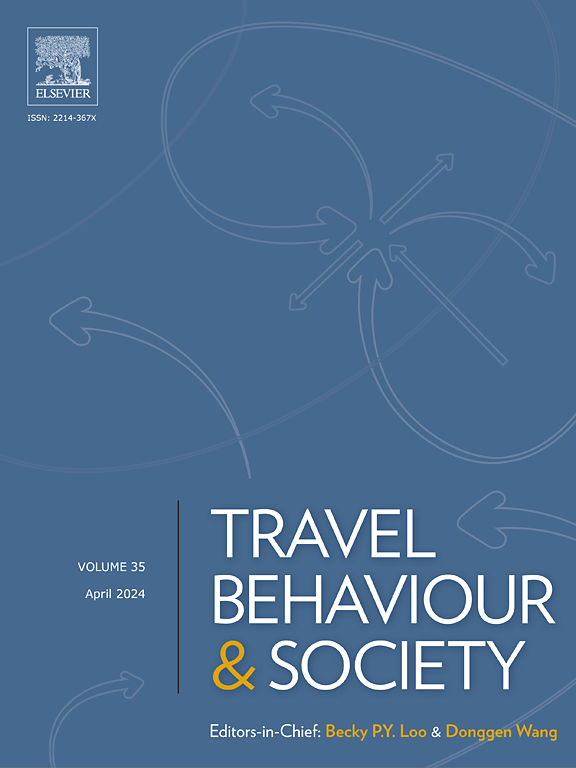评估网约车在多式联运中的作用,以最大限度地提高城市地区的出行效用
IF 5.7
2区 工程技术
Q1 TRANSPORTATION
引用次数: 0
摘要
如今,随着网约车服务的广泛采用,城市居民的出行方式选择行为发生了显著变化。然而,很少有研究系统地将网约车与综合的、门到门的多式联运公共交通(结合地铁、公交车和步行)进行比较,以更好地了解旅行者的偏好。在本研究中,我们使用真实的网约车和公共交通出行记录生成匹配的出行场景,确保出发时间和实时道路交通状况的一致性。该组合数据集将个体旅行者特征和建筑环境因素作为模式选择的内部和外部影响因素。基于这些综合数据,我们开发了一个分析框架,并应用logit模型来分析出行方式的选择。使用SHAP特征重要性确定关键模型变量。随后,我们进行了全面的数值实验和敏感性分析,以评估差异化定价策略对出行方式选择概率和运营商收入的影响。该模型应用于地铁网络快速扩张的西安。敏感性分析侧重于出发时间、网约车成本和收入等关键变量。研究结果显示,高收入人群对网约车成本的敏感度较低,而低收入人群对成本更敏感,尤其是在高峰时段。出发时间显著放大了公共交通出行时间对出行方式选择的影响。当出行成本低于30元时,所有的出行者都对网约车表现出强烈的偏好,而当出行成本超过50元时,大多数出行者选择公共交通。数值模拟进一步表明,针对低收入旅行者的有针对性的补贴可以使他们在高峰时段选择网约车的可能性提高30%以上,而不会因高收入用户的客流量增加和溢价而影响运营商的收入。这些结果突出表明,需要制定有针对性的、数据驱动的政策,以提高城市多式联运系统的效率和公平性。本文章由计算机程序翻译,如有差异,请以英文原文为准。
Evaluating the role of ride-hailing in multimodal travel to maximize travel utility in urban areas
Nowadays, with the widespread adoption of ride-hailing services, urban residents’ travel mode choice behavior has changed significantly. However, few studies have systematically compared ride-hailing with integrated, door-to-door multimodal public transportation—combining subway, bus, and walking—to better understand travelers’ preferences. In this study, we generated matched travel scenarios using real ride-hailing and public transportation trip records, ensuring consistency in departure times and real-time road traffic conditions. This combined dataset incorporated individual traveler characteristics and built environment factors as both internal and external influences on mode choice. Based on this comprehensive data, we developed an analytical framework and applied a logit model to analyze travel mode selection. Key model variables were identified using SHAP feature importance. Subsequently, we conducted comprehensive numerical experiments and sensitivity analyses to evaluate the impact of differentiated pricing strategies on travel mode choice probabilities and operator revenues. The model was applied to Xi’an, a city with a rapidly expanding subway network. Sensitivity analyses focused on key variables such as departure time, ride-hailing cost, and income. The findings reveal that high-income travelers exhibit lower sensitivity to ride-hailing costs, while low-income groups are more cost-sensitive, particularly during peak periods. Departure time significantly amplifies the effect of public transportation travel time on mode choice. All travelers show a strong preference for ride-hailing when the cost is below 30 RMB, whereas most opt for public transportation when the cost exceeds 50 RMB. Numerical simulations further demonstrate that targeted subsidies for low-income travelers can increase their probability of choosing ride-hailing by more than 30% during peak hours, without compromising operator revenue due to increased ridership and premium pricing for high-income users. These results highlight the need for targeted, data-driven policies to enhance both the efficiency and equity of urban multimodal transit systems.
求助全文
通过发布文献求助,成功后即可免费获取论文全文。
去求助
来源期刊

Travel Behaviour and Society
TRANSPORTATION-
CiteScore
9.80
自引率
7.70%
发文量
109
期刊介绍:
Travel Behaviour and Society is an interdisciplinary journal publishing high-quality original papers which report leading edge research in theories, methodologies and applications concerning transportation issues and challenges which involve the social and spatial dimensions. In particular, it provides a discussion forum for major research in travel behaviour, transportation infrastructure, transportation and environmental issues, mobility and social sustainability, transportation geographic information systems (TGIS), transportation and quality of life, transportation data collection and analysis, etc.
 求助内容:
求助内容: 应助结果提醒方式:
应助结果提醒方式:


